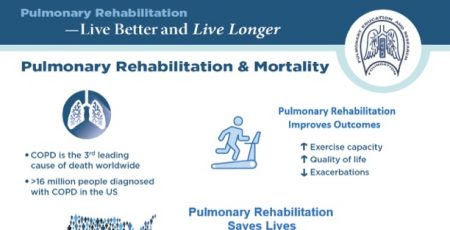07 Jul 7 Non-Drug Treatments for COPD
In addition to the many beneficial drugs that are available for the treatment of COPD, there are several effective non-drug treatments available. Chief among them are smoking cessation for continuing cigarette smokers; pulmonary rehabilitation, which focuses on exercise endurance to improve dyspnea (difficult or labored breathing) and quality of life; and long-term oxygen therapy. Other treatments available are noninvasive positive pressure ventilation (NIV), lung volume reduction surgery, minimally invasive bronchoscopic valves that have been showing promise, and finally and relatively rare, lung transplantation. Though survival rates for lung transplants are improving, this last option requires a match between a donor and recipient, a highly motivated patient, and long-term support by a specialized care team.
Telemedicine
Telemedicine shows promise in improving quality of life for all COPD patients, though it is not yet generally available. A patient connects electronically with a care consultant or consultant team, and information on the patient’s progress is transmitted, sometimes as often as daily. This information can alert the medical team to the early onset of a flare-up of COPD (acute exacerbation). The care providers can then communicate with the patient and suggest therapies including rest, oxygen, or inhalers, and help avoid emergency department visits and hospital admissions.
Smoking Cessation
It cannot be stressed enough how important smoking cessation is for continuing cigarette smokers who have COPD. There are many aids available to assist a patient’s efforts to quit smoking, including several varieties of nicotine replacement therapies (NRT) such as patches and gum. Although the administration of nicotine may be harmful to the body in its own right, still, avoiding the other components of cigarette smoke is beneficial and research has shown that tapering doses of NRT can help with smoking cessation. In addition to NRTs, two medications are available that may help a patient succeed in breaking nicotine dependency: bupropion (Zyban®) and varenicline (Chantix®). Smoking cessation classes and comprehensive care management programs can also help patients quit smoking.
Pulmonary Rehabilitation
Pulmonary rehabilitation involves an exercise and nutritional regimen to counteract the loss of skeletal muscle and improve exercise tolerance and the dyspnea that arises during exercise. Studies have not yet shown increased survival or lung function, but pulmonary rehabilitation has been shown to improve health-related quality of life, dyspnea, and exercise tolerance; the size of these improvements are usually greater than any other COPD therapy. However, the exercise and lifestyle modification program must be continued in order to maintain the improvements; if the lessons learned in a rehabilitation program are abandoned, improvements will deteriorate over time.
Long-Term Oxygen Therapy
Long-term oxygen therapy (18 or more hours of oxygen every day) is an indicated treatment for patients who chronically have low levels of oxygen in the blood, and has been demonstrated not only to improve exercise performance, but to substantially increase survival rates.
Bi-Level Noninvasive Positive Pressure Ventilation
Bi-level noninvasive positive pressure ventilation (NIV) can be effective in treating people hospitalized with acute COPD exacerbations, and can decrease intubation rates, shorten hospitalizations, and reduce mortality, but its role in home management of COPD has not been clearly established.
Lung Volume Reduction
Lung volume reduction might be a recommended treatment for COPD patients who have severe emphysema (bubble-like cavities filled with air), especially in the upper zones of the lung. These cavities can impair the function of less diseased lungs by occupying dead space within the chest cavity, trapping air. Surgical lung volume reduction removes nonfunctional portions of the lung and improves lung function and symptoms, but the procedure is uncommonly performed today. A newer method, but not yet approved for general use, to achieve similar results involves the placement of one-way valves in the lung airways, which allow gas to leave bullae but do not allow air to flow inward. Typically, several such valves are placed with a bronchoscope. The valves have been shown to provide some improvement in lung function, reduction of dyspnea, and improvements in exercise capacity. However, use of the valves has been associated with an increase in adverse effects, including acute exacerbations of COPD and collapsed lung.
Lung Transplantation
Lung transplantation is a relatively unusual option for patients with severe COPD; it is a radical procedure and the survival rate is not very high. This is an option only for patients with end-stage COPD and only when all other therapies have failed to provide relief. Only younger patients who are otherwise in good health will qualify. Common risks are primary graft failure, chronic rejection, and infection, but in successful cases, lung function and quality of life can improve dramatically.





Pingback:PERF Monthly Newsletter – July 2016 | PERF 2nd Wind Blog
Posted at 07:48h, 31 July[…] …Read more […]